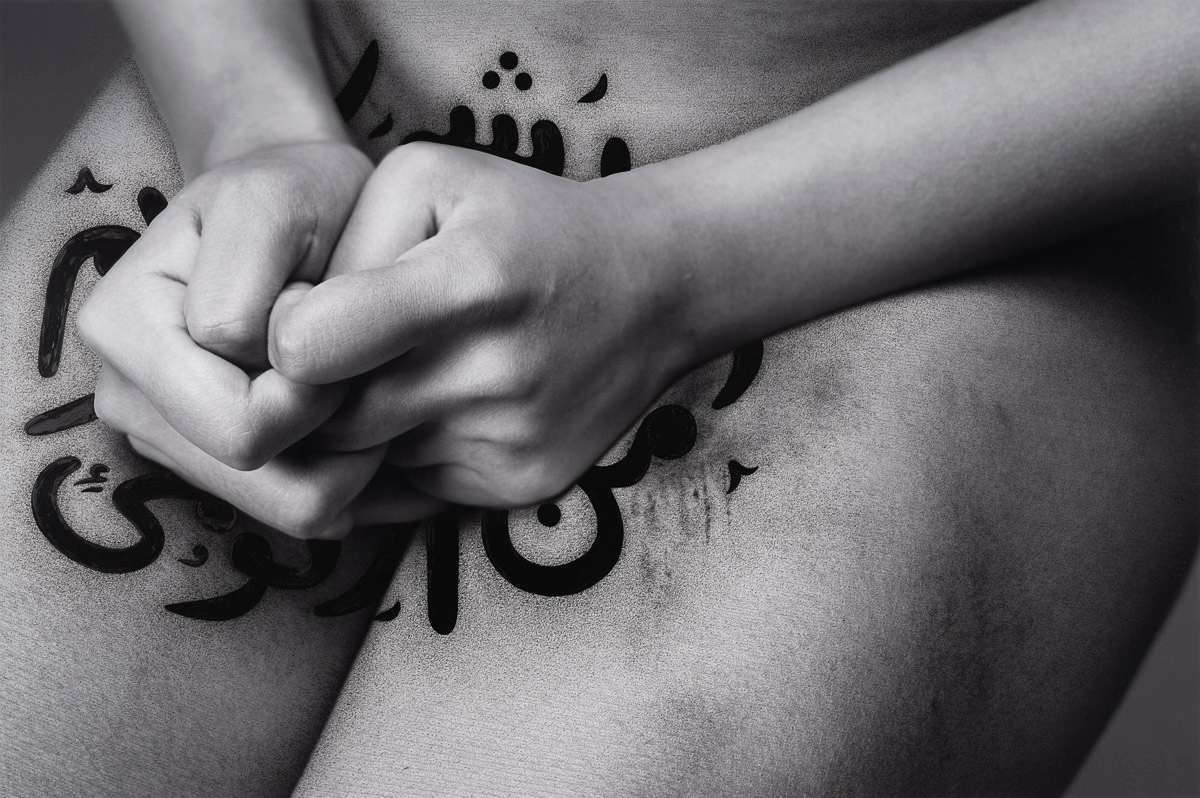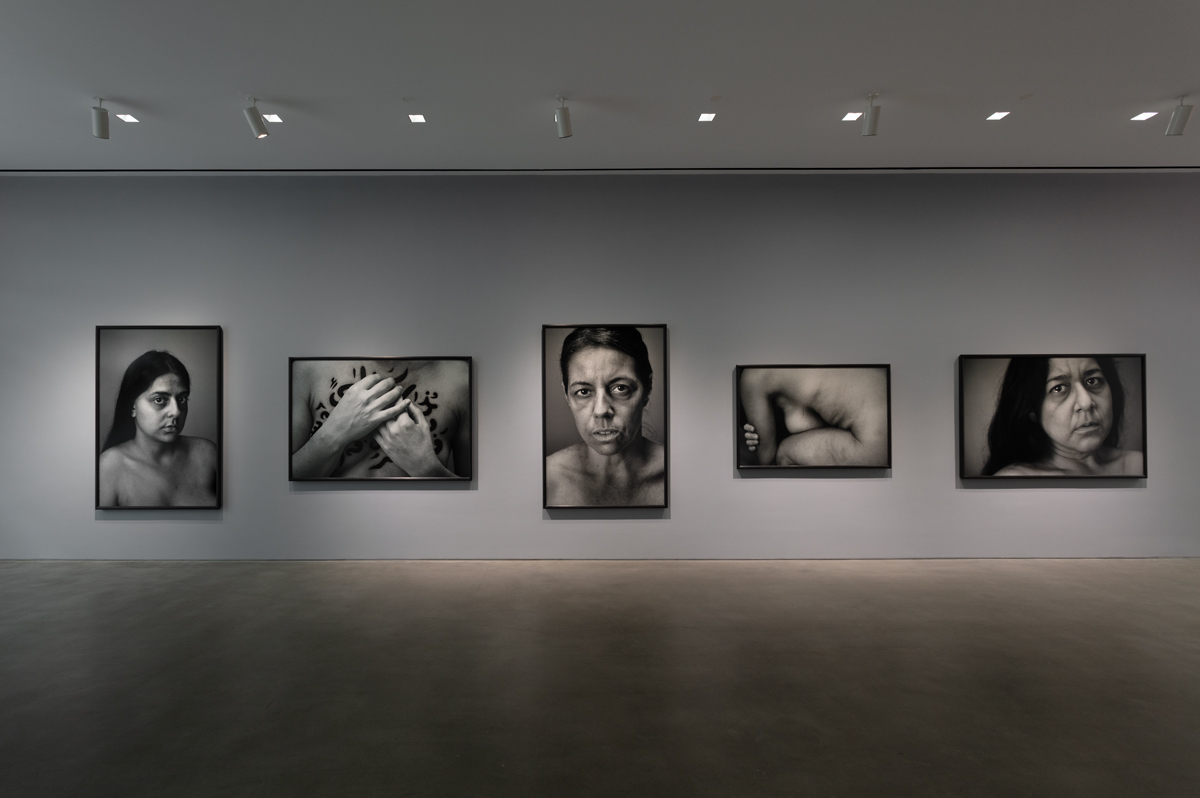 Aruna D’Souza
Aruna D’Souza
In a new show, Shirin Neshat moves from Orientalizing Middle Eastern women to instrumentalizing Black and brown bodies.

Shirin Neshat: The Fury, installation view. Courtesy the artist and Gladstone Gallery. Photo: David Regen.
Shirin Neshat: The Fury, Gladstone Gallery, 515 West Twenty-Fourth Street, New York City, through March 4, 2023
• • •
Shirin Neshat’s current show at Gladstone consists of ten new photographs—portraits of women, mostly nude, overlaid with tiny Persian calligraphy transcribing Forough Farrokhzad’s poetry of feminine desire—and a sixteen-minute, two-channel video projected on opposing walls. (Both elements of the exhibition share its title, The Fury.) The beautifully shot, expertly edited black-and-white video addresses the trauma of rape and torture experienced by female political prisoners of the Islamic Republic in Iran, the press release explains. Images move between the memories of a woman—she is as much icon as character, as is typical in Neshat’s work—and her contemporary life in Brooklyn, where she remains haunted by her past. Though made the spring before Iranian morality police murdered twenty-two-year-old Mahsa Amini in September 2022, leading to months of women-led protests, it is impossible to separate Neshat’s work from those events, especially given the way she’s positioned herself as a spokesperson for the cause of Iranian women for her whole career.

Shirin Neshat, The Fury, 2022 (still). Two-channel, HD monochrome video, 16 minutes 15 seconds. Courtesy the artist and Gladstone Gallery. © Shirin Neshat.
Neshat is arguably the most famous Iranian artist in the world, an emigrant (and later exile) since 1975, just before the Islamic Revolution. She is a maker of riveting, sumptuous films, videos, and photographs that explore the ways patriarchal systems turn women’s bodies into sites of ideological struggle. In the first part of her career, that system was Iran’s theocratic state. This early work often featured women in chadors victimized by or resisting (or, as often, both at once) men, male power, the male gaze. Since around 2012, she has expanded her purview to focus on other subjects, including her adopted home of the US. She’s said in interviews that the shift was motivated by her desire to move past the “nostalgia” of dwelling on her place of origin.

Shirin Neshat, Seema, from The Fury series, 2023. Digital C-print with ink and acrylic, 48 × 72 inches. Courtesy the artist and Gladstone Gallery. © Shirin Neshat.
Neshat is both widely celebrated and wildly controversial. For some, she heroically sheds light on the repressions of the Islamic state, speaking truth to power. For others, she trades on stereotypes of the Muslim world that are all too common in the West and proposes images that are cravenly in line with America’s justification for its imperialist exploits in the Middle East—saving Muslim women from Muslim men. (It’s worth noting that her career has spanned the period from the first Gulf War through the War on Terror.) As recently as 2019, speaking with Carolina A. Miranda of the Los Angeles Times—after three decades of winning prizes, being collected by major global institutions, and having countless exhibitions—she still felt the need to defend herself against that reproach: “One of the things I battle with in the Western media is that no matter my work—whether the woman is protesting, is rebellious, is breaking the norms, whether it’s through a state of madness or walking out, they have stood up against the system. Yes, there are oppressions, but women have stood up. The biggest fighters in Iran today are the women. The most unafraid people in Iran are women. I’ve always tried to say that.”

Shirin Neshat: The Fury, installation view. Courtesy the artist and Gladstone Gallery. Photo: David Regen.
Given her sensitivity to such criticism, it’s hard to parse the way her new show was announced on Gladstone’s Instagram page: the teaser photo shows a woman, wearing underpants and a bra so carefully calibrated to her skin tone that she appears naked, curled up on the floor. She’s in a large, brick-walled building that might be a prison, surrounded by a tight circle of men in military dress whose looks convey curiosity, judgement, indifference, disdain, or desire. It is a nausea-inducing image of pure vulnerability, of a woman beaten down by male authority. The post was inundated with comments, largely by women of the Iranian diaspora, who noted the irony of this scene of victimization at the precise moment when participants in the “Women, Life, Freedom” movement were courageously, at very real risk to their lives, leading a historic fight against their government. “Amplify ACTUAL VOICES OF IRANIAN WOMEN not this objectifying oppressive oriental bullshit [sic],” read one that summed up the mood.
The good news is that the image is a film still in the old-fashioned sense of the word: it doesn’t appear in The Fury, but was photographed separately to convey the video’s content. The bad news is that the piece is immeasurably worse than the still suggests.

Shirin Neshat: The Fury, installation view. Courtesy the artist and Gladstone Gallery. Photo: David Regen. Pictured: The Fury, 2022. Two-channel, HD monochrome video, 16 minutes 15 seconds.
The video is slowed down, often bleached out, and set against a soundtrack by Johnny Azari that includes a haunting, slow-tempo song performed by Emel Mathlouthi; together, these choices amplify the dreamlike narrative structure. This is what we see: a man in military uniform (the almost impossibly beautiful Tony Azar) smokes a cigarette as he looks out from a screen toward another on the opposite wall, which shows a woman (Sheila Vand), eyes heavy with kohl and dressed in a sequined gown, dancing seductively for him. The scene cuts to her walking, numb and dazed, on the streets of Brooklyn, under the BQE, past people in the neighborhood going about their lives. Some don’t notice her; others consider her with curiosity, suspicion, empathy. (The whole film is structured around the inscrutability of peoples’ gazes.) Everything points to her alienation. Next, we are thrown back to the military man and the dancer, who is suddenly in the center of a prison, with men scattered around the perimeter, standing or lounging on chairs. She undulates like Salome as they watch, in a scene that seems straight out of a canvas by Jean-Léon Gérôme, the nineteenth-century French painter synonymous with Orientalism, and its play between male power and desire. She approaches the initial military man; he blows smoke into her face. She backs away, and we see that her body is covered in bruises and scratches. She continues her performance, but now broken, stumbling, scared, struggling to put one foot in front of the other. The screens cut to her running down those same Brooklyn streets. A woman looks at her dazed countenance with concern and screams noiselessly on her behalf. A drumbeat rises as people on the street start following her, executing a choreography that is at first zombielike and then increases in energy, turning into something like a riot. In a culminating image, a young man takes a baseball bat to a car windshield, each of his blows synced to the drumbeat; the scene is shot from inside the car, so that the violence seems directed at us, the viewers.

Shirin Neshat, The Fury, 2022 (still). Two-channel, HD monochrome video, 16 minutes 15 seconds. Courtesy the artist and Gladstone Gallery. © Shirin Neshat.
In a film installation about which there is much to critique, this is most egregious to me: all the “rioters” are Black and brown. Neshat, not satisfied with her usual schtick of stereotyping Iranian men and women, uses Black people and other people of color to act out the violence felt by her abused main character. Her fury, the aftereffect of her trauma, is expressed through these instrumentalized bodies. It is a perverse message—not just because of the righteous anger of Iranian women spilling out into public space in the bravest and most dramatic ways lately (they don’t need anyone to act on their behalves), but because we are living in an era, and in a country, where other minoritized folks have their own shit to be angry about. This is Black Lives Matter put into service of the victims of Iran’s brutal regime: Neshat is not declaring solidarity with that cause, but mining stereotypes of Blackness in the most cynical way and using them to enact the rage her character cannot. And to that, I say: no way.
Aruna D’Souza is the 2022–23 W. W. Corcoran Professor of Social Engagement at the Corcoran School of Art and Design in Washington, DC and a contributor to the New York Times and 4Columns. She was awarded the Rabkin Prize for arts journalism in 2021.